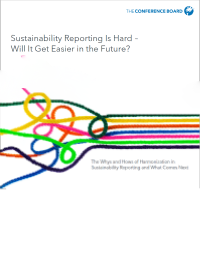The Whys and Hows of Harmonization in Sustainability Reporting and What Comes Next
After a decade of proliferating sustainability reporting frameworks, we now appear to be entering a period of “harmonization” – i.e. the connecting of one framework to another for comparison and alignment purposes, a reduction in variations across frameworks, and possibly even some consolidation of frameworks. Or are we? Over the past two years, a host of initiatives have been launched to “harmonize” various aspects of sustainability reporting. But the impact and staying power of many of these initiatives are still uncertain.
Why is harmonization important? For one, the corporate sustainability standards and reporting landscape has become hugely complex and cumbersome to navigate, both for companies and for their stakeholders. For another, there is still a lack of consistent and comparable data to inform business and investment strategies and easily measure progress against targets set at the company, national, and international levels. Harmonization portends to fix both problems.
While the benefits of harmonization are clear to most, how uniform sustainability standards can be without forgoing important details on materiality – i.e. the specifics that matter to a company, industry, jurisdiction, or stakeholder group – is a point of much contention.
In this report, we outline and assess the many new harmonization initiatives in play. We look at who is involved, what the objectives of the various initiatives are, their progress-to-date, and how their outcomes may impact corporate sustainability reporting going forward. Members can use this compendium to identify the initiatives of most relevance to their business and adapt and align accordingly.
Detailed descriptions of all initiatives discussed throughout the report can be found in a separate Appendix – Appendix A: Harmonization Initiatives Details.
Insights for What’s Ahead
We are currently amidst a development phase that, unfortunately, further muddies the waters of sustainability reporting. Many competing or partially competing standards, frameworks, and information collection schemas now exist. Most are voluntary, but mandatory standards are emergent. Everyone realizes that the various frameworks, both voluntary and mandatory, must be made to better work with one another, or at least be streamlined into a manageable set of options.
Although many initiatives are underway, there is not yet much progress towards real harmonization across major reporting standards. In fact, the development of new standards continues apace, and the complexity of reporting thus continues to increase. Nevertheless, a groundswell of activity is in motion which may reduce complexity longer-term. Companies should carefully monitor harmonization progress to assure that their sustainability reporting roadmap is aligned with key development trajectories.
Expect more alignment across the major voluntary reporting frameworks, but no real consolidation of standard. The main aim of most of the harmonization initiatives currently underway is to improve the alignment of voluntary reporting criteria and standards with one another. The approach recognizes the different but complementary value of the various standards that have been adopted in the marketplace.
- The main organizations currently involved in alignment efforts of voluntary standards are the Global Reporting Initiative (GRI), the Sustainability Accounting Standards Board (SASB), the International Integrated Reporting Council (IIRC), CDP, and the Climate Disclosure Standards Board (CDSB). Companies should expect a prolonged period of repositioning among these and other organizations, but not a new, common standard for voluntary reporting that all these groups agree on.
With voluntary reporting standards in flux, efforts to introduce mandatory reporting standards are ascendant. Progress on the EU’s reporting requirements and the potential introduction of sustainability reporting standards from the International Financial Reporting Standards (IFRS) Foundation are the key developments to monitor on the mandatory standards’ front.
- In Europe, there is a clear push towards establishing common and binding sustainability reporting rules. This will be a major gamechanger once fully implemented. Companies operating within the EU will have to adjust to a host of new and complex disclosure rules, especially first-time reporters who fall within the extended scope of the Corporate Sustainability Reporting Directive (CSRD). The EU regulations are likely to have knock-on effects in other regions, especially in areas regarding climate change.
- If the IFRS Foundation indeed decides to develop its own sustainability reporting standards, these would likely be widely used by publicly listed companies and could potentially become the blueprint for voluntary and/or mandatory stock market disclosure requirements in many countries.
- Jurisdictional differences will likely remain. Although the US Securities and Exchange Commission (SEC) is currently considering a substantial overhaul of its climate disclosure requirements, it is likely that whatever new framework the SEC develops will be different from EU standards. This means companies will have to fulfil distinct disclosure obligations in both jurisdictions. A similar reality is likely for other jurisdictions where mandated sustainability or climate-specific reporting is introduced.
Prepare now for an increasing focus on quantitative data and methodological rigor. One thing that is common to the various harmonization efforts now underway is that there is a big push to develop standardized methodologies to calculate and present relevant quantitative data. Progress in this area will greatly enhance transparency and comparability, and likely bear great influence on corporate behavior as a result. The EU Taxonomy, introduced last year, is a major step in this direction.
- In a nutshell, the EU Taxonomy is a tool that enables a homogenous evaluation of the climate and environmental performance of companies and their assets. A significant share of financial market participants and companies operating within the EU are required to disclose the extent to which their products or activities are environmentally sustainable as defined by the EU Taxonomy. Likewise, other initiatives, like the Transparent Project and the Value Balancing Alliance, which aim to develop natural capital accounting and valuation standards, may play an important role in bringing “sustainability accounting” into the mainstream, especially within the EU.
- Companies should expect that the time and resources needed to implement these new methods will be significant. Even though the harmonization of methods is still at a debate stage, there is no debate that more clarity and transparency is needed regarding how reported data and metrics are defined and measured. Current developments around carbon measurement and disclosure are a signpost of what’s to come in other areas of sustainability and eventually across the board. Companies should prepare in advance for this eventuality.
During this period of flux and change, key customer/stakeholder requirements should determine which standards or frameworks a company uses, irrespective of goings on with harmonization initiatives.Companies should ground their reporting approach on the requirements of the audience they wish to engage and embrace the standards of most importance to this audience. Centering planning on “voice of the stakeholder” reasoning always makes good sense.












